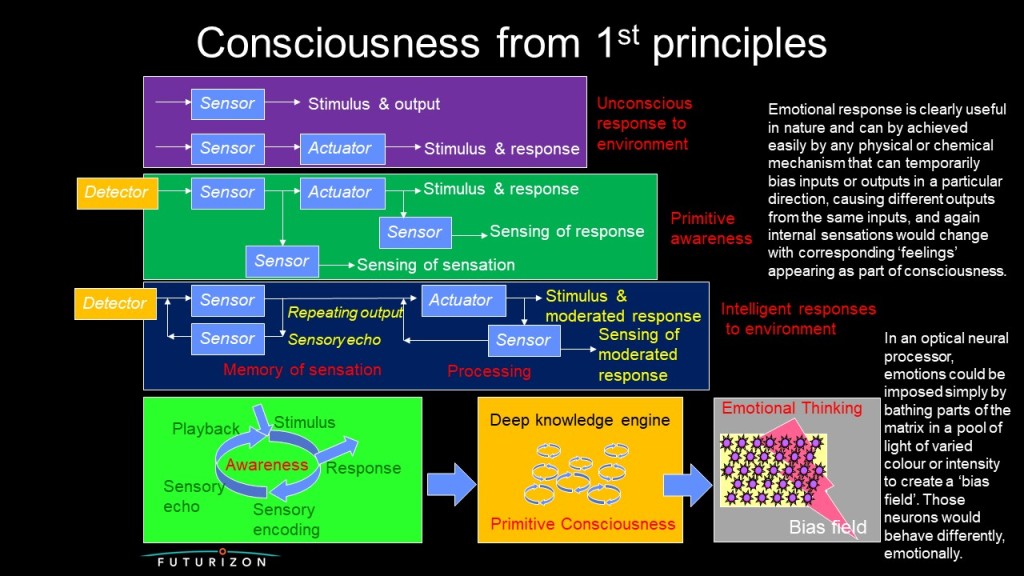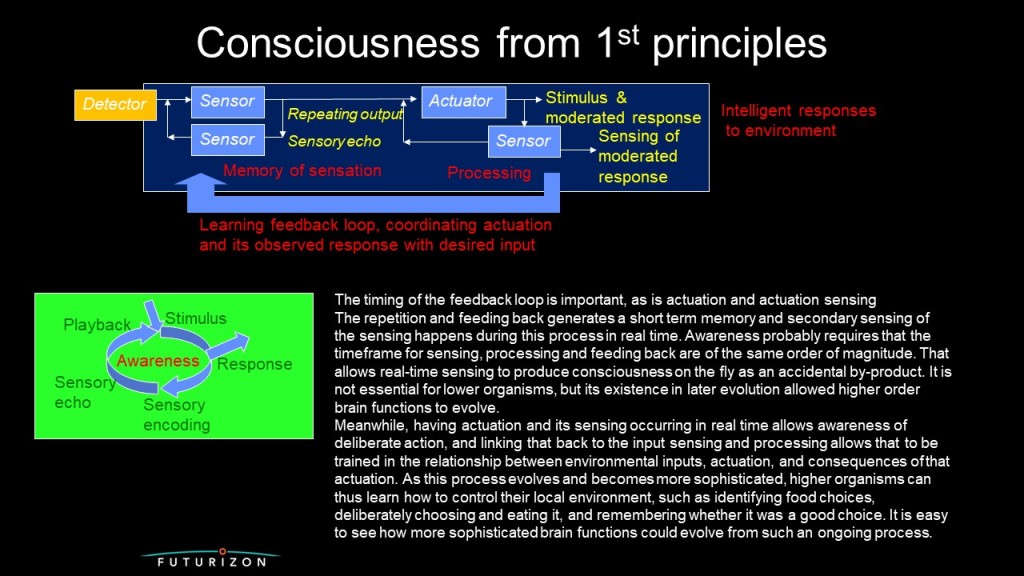Introduction:
The quest for achieving machine consciousness has been a driving force in artificial intelligence (AI) research. While significant progress has been made in various AI domains, the pursuit of truly conscious machines remains an open challenge. In this blog, we explore a novel approach to machine consciousness that combines triangular (3 terminal) adaptive analog neurons, biomimetic training mechanisms, and feedback loops.
The Idea: Triangular Adaptive Analog Neurons
The proposed approach is centered around the development of 3-terminal neurons, logically triangular, in very large numbers, arranged in a compact hexagonal pattern on a wafer-scale processor. These neurons are designed with connections that can serve as input or output at any time, allowing for dynamic reconfiguration during operation. This unconventional design offers several potential benefits, including simplicity, adaptability, and scalability in terms of hardware implementation. Furthermore, the use of adaptive analog neurons, as suggested by AI pioneer Hans Moravec, could lead to greater energy efficiency, robustness, and continuous learning compared to digital counterparts. Analog noise can be expected but biological systems generally cope extremely well with noise and it has been shown many times that it can actually work to advantage in a conceptually generative system so if used well, could accelerate development rather than impede it.
Biomimetic Training Mechanisms: Signal Regeneration and Feedback Loops
Images from my 2018 blog: https://timeguide.wordpress.com/2018/06/04/biomimetic-insights-for-machine-consciousness/
The approach to machine consciousness I described in that blog would be very well-suited to 3-terminal neurons.


Instead of relying on traditional feed-forward and backpropagation techniques for training neural networks, the proposed approach uses biomimetic training mechanisms inspired by natural biological processes. This involves signal regeneration and extensive use of timed feedback loops that feed processed signals back into neuron inputs in sync with the sensing operation. By leveraging the “sensing of sensing” phenomenon, the system can self-calibrate levels and weightings to establish machine consciousness.
Benefits of the Proposed Approach
- Biomimetic Inspiration: Drawing from biological systems can potentially lead to the development of more efficient, adaptive, and resilient AI architectures. Incorporating natural mechanisms like signal regeneration and feedback loops could result in unique properties and capabilities that are not present in traditional AI systems.
- Energy Efficiency: By using adaptive analog neurons, the proposed approach may offer significant energy savings compared to digital computation, making it more suitable for large-scale and continuous learning tasks.
- Adaptability and Self-Organization: The dynamic nature of the connections in the proposed 3-terminal neuron-based network could enable greater adaptability and self-organization. This might lead to the emergence of new and interesting behaviors, as well as more efficient and adaptive architectures.
- Novel Learning Algorithms: Developing new ways of programming and teaching the proposed system could lead to the discovery of innovative learning algorithms and techniques that take advantage of its unique properties.
Challenges and Considerations
- Hardware Implementation: The fabrication of a wafer-scale processor with triangular 3-terminal neurons, especially in an analog setting, could be challenging due to factors such as noise, precision, and scalability. It is essential to consider these factors during the design and fabrication process.
- Training and Optimization: Developing biomimetic training mechanisms based on signal regeneration and feedback loops could be a significant research challenge. It will likely require extensive experimentation and adaptation of existing learning algorithms.
- Evaluation and Benchmarking: Demonstrating the effectiveness of your approach in achieving machine consciousness will require the development of suitable evaluation methods and benchmarks. This could be challenging given the unconventional nature of your proposal.
- Scalability and Generalization: Ensuring that your approach can scale to large, complex problems and generalize across different domains will be crucial in demonstrating its potential as a viable AI tool.
Conclusion:
The proposed approach, which combines triangular adaptive analog neurons, biomimetic training mechanisms, and feedback loops, offers a fresh perspective on achieving machine consciousness. By drawing inspiration from natural biological processes and leveraging the unique properties of the proposed architecture, this approach could potentially yield significant advancements in the field of AI and machine consciousness. While there are challenges associated with the implementation, training, and evaluation of this system, pursuing this line of research could lead to the development of more efficient, adaptive, and powerful AI tools.
Moreover, this approach could potentially disrupt the AI landscape by introducing a new paradigm that deviates from traditional digital computation and learning techniques. By focusing on hardware efficiency, adaptability, and novel learning algorithms, the proposed system might carve a unique niche in the rapidly evolving AI ecosystem.
Future Research Needed:
As we embark on the exploration of this intriguing approach to machine consciousness, several future research directions can be pursued to further understand and develop the proposed system:
- In-depth study of triangular adaptive analog neurons: A thorough investigation of the properties, dynamics, and performance of triangular adaptive analog neurons is essential to refine their design and optimize their implementation.
- Development of biomimetic training algorithms: Extensive research should be directed towards the development and fine-tuning of biomimetic training algorithms that leverage signal regeneration and feedback loops for self-calibration and learning.
- Exploration of network architectures: Investigating different network architectures and connection strategies could provide valuable insights into the most effective and efficient configurations for achieving machine consciousness using the proposed system.
- Integration with existing AI techniques: Combining the proposed approach with existing AI techniques, such as deep learning and reinforcement learning, might enable the development of hybrid systems that take advantage of the strengths of both analog and digital computation.
- Real-world applications: Identifying and pursuing real-world applications that can benefit from the unique properties of the proposed system is crucial in demonstrating its practical value and potential impact on various domains.
In conclusion, the exploration of machine consciousness using triangular adaptive analog neurons and biomimetic training mechanisms presents an exciting and promising direction for AI research. By addressing the challenges and capitalizing on the potential advantages of this unconventional approach, we might witness the dawn of a new era in AI development, where machine consciousness becomes an achievable reality.







Pingback: AGI development Part 3 | Timeguide - The future before it comes over the horizon
Pingback: This retirement lark is hard work | Timeguide - The future before it comes over the horizon